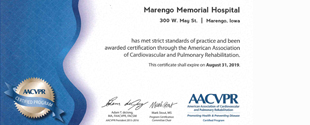FOR THE HEALTH OF IT - Strong heart, strong bones
February 11, 2015By: JESS NABOR
RTRCT Radiology Technologist, Compass Memorial Healthcare
As healthcare professionals we like to focus on every aspect of our patient's health. As we celebrate National Heart Month in February, we want to remind everyone that keeping your bone strength at a healthy level is also important. A bone mineral density (BMD) test is the best way to measure your bone health. It can show:
Whether you have osteoporosis, a disease that makes your bones weak; your risk for breaking bones and your response to osteoporosis treatment.
Low bone mass that is not low enough to be osteoporosis is called osteopenia. Some causes of low bone mass include family history, not developing good bone mass when you are young, and having certain conditions or taking high risk medicines. Not everyone who has low bone mass gets osteoporosis, but they're at a higher risk.
The National Osteoporosis Foundation as well as the American Association of Clinical Endocrinologists recommends all women aged 65 and over, as well as women and men after age 50 who experience fractures, get a bone density test. They also suggest that younger women who have gone through menopause and have one or more risk factors get tested too. Some risk factors include family history of osteoporosis, eating disorders, inadequate calcium intake, Vitamin D deficiency, smoking and alcohol abuse.
If you have low bone mass, there are things that you can do to help slow down bone loss. These include eating foods that are rich in calcium, vitamin D and doing weight-bearing exercise such as walking, bowling or dancing. Your doctor may also prescribe medications to prevent osteoporosis.
So this Valentine's Day when you get the gift of chocolate, set the box aside and ask your partner to take a stroll before you take a bite. You can have both, strong bones and your chocolate treat to keep you both healthy and happy.
January 19, 2015
By: BARB TAYLOR, RHD
Dietician, Compass Memorial Healthcare
Did you make resolutions this year to become healthier? Maybe even to become gluten-free? It seems that the number of people diagnosed to start down a path of gluten free products is increasing in numbers every year. As we see more of this in our patients, staff and community members, we have to ask ourselves the following questions: Is gluten restriction healthy? What about the Wheat Belly concept?
Consider the scientific evidence about these beliefs:
Gluten restriction is not healthier. Products with wheat protein (breads, pastas,etc) have numerous nutrients added to replace those nutrients removed in making white flour. Folic acid, calcium, B vitamins, iron are required and inulin (a processed fiber) is often added. Non-gluten grains used for gluten free products including rice, quinoa, potato starch are generally not enriched with these nutrients.
To make the textures wanted in a bread product, more fat and/or sugar is likely to be added. This will likely make the gluten free product higher in calories than the wheat equivalent.
The gluten protein has some evidence of support for management of triglycerides, blood pressure and the bacterial flora of the digestive system.
Rice is a natural source of arsenic, found in soils and in small amounts in the body. The rice plant, as do some others, use the arsenic in the soil as part of their growth needs. In normal amounts of intake, this is no problem. But with rice being one of the major flours used in gluten free products, it can become a concern. Gluten free diets should encompass a variety of grain products, just in case.
Weight management from gluten free products is a mirage. It is not a function of the absence of wheat, use of sugar and fat in gluten free products. Weight loss in those with celiac disease is not created from the lack of wheat, but from the reduced ability to digest nutrients properly. Weight loss on a gluten free diet is generally the result of a healthier intake of fruits and vegetables instead of reduction in gluten.
Gluten free products are about twice as expensive as their wheat counterparts. For example, gluten free biscuit mix can be 28 cents per serving more expensive than its wheat counterpart; brownie mix can be up to 8 cents more per serving; Nut Thins are usually about twice the price of equivalent wheat crackers.
Be sure that the gluten free products you buy are actually gluten free. A new standard of 20 ppm was only implanted in 2014. Products tested before that date may contain some gluten or be produced in a facility where cross contamination might occur.
If you think you have a gluten sensitivity, it is important to have the doctor test for you. Other causes for your ailments may be responsible for your symptoms. Since elimination of gluten may not relieve the symptoms, other foods may be eliminated until you are eating an inadequate diet. There are several intestinal disorders that mimic each other and symptoms won' be relieved until the right cause is identified.
If you must eat a gluten free diet: Buy a variety of grains such as amaranth, quinoa, corn, teff, millet and rice so you have a variety of nutrients. Buy naturally gluten free foods; more fruits and vegetables, lean meat and poultry, legumes, dairy and nuts. Instead of pasta use potatoes, winter squash (think spaghetti squash), lima beans, edamame for your starchy uses. Check labels on gluten free products for their sugar, fat and sodium content and any enrichment they may have for informed purchases.
If you believe you have a gluten allergy, go see your doctor. They can run specific tests to lead you to a better, healthier life style that may or may not include gluten free guidelines. The New Year is always a great time to start healthier lifestyle choices, so start a food journal, join a fitness club, and always get in your fruits and vegetables!
January 12, 2015
By: LORIE CHRISTY
Manager of Respiratory Therapy Services
COPD, chronic obstructive pulmonary disease (includes emphysema and chronic bronchitis) and cold weather is not a good mix but you do not have to hibernate inside all winter. There are precautions you can take to make this winter a more tolerable season. Follow some of these hints to easier breathing when you step outside:
- First, get your flu shot and make sure your pneumonia vaccination is up to date. Many COPD sufferers have a weakened immune system, which makes you more susceptible to flu and pneumonia.
- If you have a bronchodilator (inhaler), use it approximately 30 minutes before you know you will be going outside. The effect of cold air on COPD sufferers causes narrowing of the airways leading to shortness of breath and wheezing. Using your bronchodilator will relax the airways to help ease your breathing so when those temperatures drop you can be active outdoors with family and friends. Take your bronchodilator with you when you venture out. Always check with your physician first and take medications as prescribed.
- When you go outside wear a mask or scarf around your nose and mouth. The use of a mask or scarf to cover your nose and mouth will make the air warmer and less irritating to the airways. Try to breathe through your nose; it naturally warms and humidifies the air.
- Dress in layers that are loose fitting so not to constrict your breathing, and to keep you warm.
- If you use oxygen keep the tubing inside your clothing so it stays warm.
- Try not to over exert yourself and limit your exposure to the cold.
- In your home you will want to keep your furnace filters clean to help eliminate airborne contaminates.
- Have a reserve of food on hand so you will not be forced to go out in severe weather conditions.
- Wash your hands often and try to limit your exposure to people who are ill. Try to avoid areas with large crowds of people where the ratio of potentially ill people is higher.
- Pulmonary Rehabilitation is a great way to have monitored exercise indoors, but if you do not attend pulmonary rehab try to have an indoor exercise routine your physician has approved so you can stay active.
Monitor yourself for signs and symptoms of a respiratory illness or a change in your breathing. Call your doctor if you notice changes such as: Increased shortness of breath, wheezing, or coughing. Increase in mucus or change in the color or consistency, swelling in ankles, legs or around your eyes. Dehydration, change in urine color. Fever and or chills.
Winter months can be a challenge for COPD sufferers but with some planning and attention, you can be active and lessen the chance of any flare ups.
These tips are general guidelines; please contact your physician for more personal advice.
Compass Memorial Healthcare has a pulmonary rehabilitation program available, doctors order required, focusing on education of your lung disease and monitored exercise to help strengthen you, keeping in close contact with your physician on your progress. For immediate attention, go to the closest emergency room if you find yourself in need of services.
January 5, 2015
By: WILLIAM GRIMM
Director of IT Services and Patient Information
Did you know in 2014 you and your family were required to have health insurance or potentially pay a penalty on your 2014 taxes?
The Patient Protection and Affordable Care Act, commonly referred to as Affordable Care Act (ACA), or "Obamacare" requires you and everyone in your family to have qualifying coverage meeting minimum standards, qualify for an exemption, or make a shared responsibility payment. For those that file taxes, you will be required to answer a question regarding whether or not you and your dependents had insurance in 2014. Since 2014 has already passed, some may be shocked when they file taxes and realize they missed the opportunity to sign up for coverage. As a member of the staff at Compass Memorial Healthcare I want to provide a list of some opportunities each of us can take in 2015 to make sure you have health coverage or at least understand some of your options.
Health insurance is typically acquired three ways. First you have government sponsored health care including: Medicare (for those over 65 and disabled), Medicaid (for lower income people and families, and TriCare (For military families). Second you have employer sponsored health care. (This typically requires you working at least 30 hours per week and the cost is typically split between you and your employer.) Third you can purchase your own health care policy on the open market place or a health care exchange. (You can receive a tax credit that will help you pay for your own policy).
We understand health insurance is hard to understand and even with the ACA mandate the price of insurance can still be out of reach for some and applying for Medicaid is not always easy. With that being said, I want to explain a program many of you may not know about. As part of the ACA each state was provided additional federal funding to expand their Medicaid to cover adults under 65 with income up to 133% of the federal poverty level. Iowa has expanded Medicaid funding and with that change adults with no children and low income can qualify for Medicaid, but the questions comes up: How do I become eligible for this extra funding?
Forms can be obtained through Compass Memorial Healthcare Patient Access (through the registration area). The complete Medicaid application takes a while to complete and then needs processed. Sometimes health care needs cannot wait for full Medicaid determination. Presumptive Eligibility allows us to presumptively enroll you in Medicaid for a thirty day period based on questions you answer. We take an application from you, enter the information in the Iowa Medicaid Portal Application, and within seconds have a determination of whether the applicant is presumed eligible for Medicaid. After Presumptive Eligibility approval you have Medicaid for up to 30 days. The state will contact you to determine if you qualify for continued Medicaid beyond that time or help with finding affordable medical coverage. Compass Memorial Healthcare is a qualified entity to determine Presumptive Eligibility for adults, parents, children, and Pregnant Women.
In summary, be sure to review the new rules regarding health insurance mandates. Don't be caught uninsured or uneducated on what is available to you! More information can be found at http://www.medicaid.gov/Medicaid-CHIP-Program-Information/By-Topics/Eligibility/Downloads/2014-Federal-Poverty-level-charts.pdf or you can go to the hospital's website at www.MarengoHospital.org and click on a link under Patient Information.





























